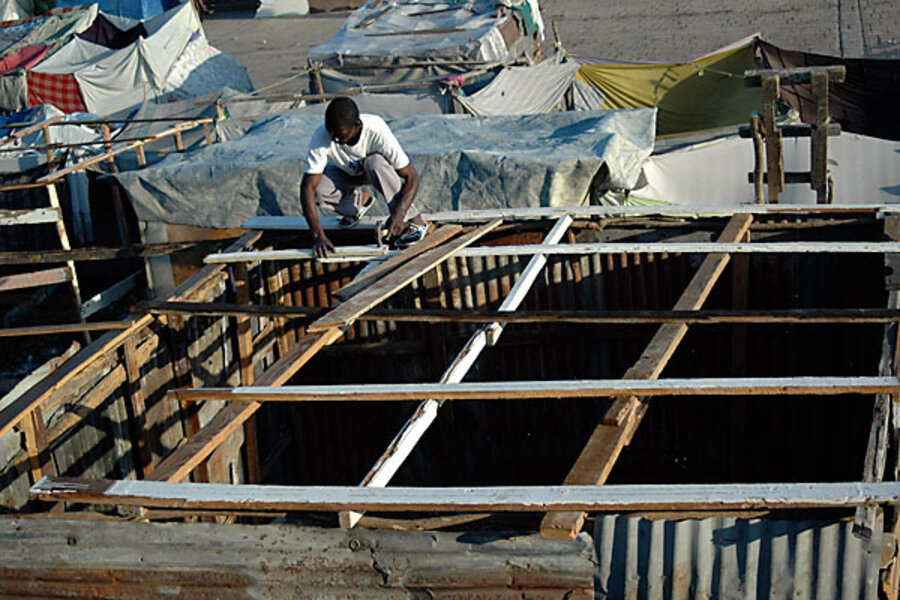Haiti's pressing need: rain-resistant shelter for 750,000 homeless
Loading...
| Washington
Haitians keeping one eye on the sky may be looking for the arrival of Angelina Jolie, the United Nations goodwill ambassador scheduled to visit humanitarian-aid sites in the earthquake-ravaged country on Tuesday.
But on other days the sky-watching has more to do with worries about rainfall and Haiti’s approaching rainy season. The rains, which so far have steered clear of the devastated capital of Port-au-Prince, will add to Haiti's relief effort a new layer of health and shelter challenges, say international humanitarian officials and disaster experts.
And despite the massive initial outpouring of aid from the world and the US in particular, the sheer size of the needs – coupled with a debilitated Haitian government – means that assistance is falling short, especially for shelter.
“Our concern now is that the rainy season is about to come,” says Kim Bolduc, UN Secretary General Ban Ki-moon’s deputy special representative to MINUSTAH, the UN’s stabilization force in Haiti. “The priority now is on delivering some sort of hurricane-proof shelter.”
Rain any time now
The Caribbean hurricane season does not start until June or July. But Haiti’s rainy season begins earlier, with showers heavy enough to cause landslides and to complicate rubble-removal efforts possible at any time.
The chief concern: how the rains will affect the makeshift camps where more than 500,000 Haitians have taken up emergency residence, building small huts of sheets or tarps or setting up donated tents. The camps’ precarious living and sanitation conditions will deteriorate further with regular rainfall, relief experts say.
“With the rains will come increased health and sanitation concerns,” says Ms. Bolduc, who spoke from Port-au-Prince to reporters via webcast on Monday.
Even without the rains, Haiti’s needs remain daunting four weeks after a devastating 7.0-magnitude earthquake.
• Of an estimated 1 million homeless, roughly 250,000 have received temporary or medium-term shelter. That means three-quarters of a million people are without minimal shelter or are crowding in with family members or friends.
• Sanitation remains a “weak spot” in the relief effort, experts say, with only about 1 of every 20 latrine requests filled so far. (Relief groups like Oxfam are working to remove thousands of tons of human waste and garbage from the camps before they become an extreme health hazard, but water supplies and shelters are still being affected.)
• The World Food Program estimates it has enough food supplies – consisting almost exclusively of rice – on hand for several months. Now the UN’s Food and Agriculture Organization (FAO) reports a disappointing response to its Haiti appeal, which means that plans to ramp up Haiti’s spring planting season could fall short and leave Haiti more dependent on imported food.
• The Port-au-Prince seaport, severely damaged by the quake, remains only partially open. Efforts to deliver materials for sturdier hurricane-resistant shelter will probably be adversely affected.
• The “humanitarian corridor” passing over land from the Dominican Republic into Haiti is literally sinking under the weight of convoys bringing in supplies. Part of the road just inside the Haitian border follows a lake shore – and the lake level is rising from mountain rains, disrupting deliveries. The US Army is working with Haitian officials to develop another route.
Rain-resistant shelter the top priority
But much of the medium-term relief effort is focused on shelter.
Haiti's government has identified several sites around Port-au-Prince where hurricane-resistant camps might be built. But, already, one of the sites is embroiled in controversy with the landowner, while shelter experts worry about how the heavier materials – lumber, aluminum sheeting – will get into the country.
“With only 2 to 3 percent of Haiti’s forest cover remaining, there’s no alternative but to import the great majority of the lumber they’re going to need,” says Gorav Seth, international programs manager with Trees for the Future, a Maryland-based organization that has been involved in Haiti in reforestation and agro-forestry projects since 2002.
Given Haiti’s two rainy seasons, he adds, an intensive planting of fast-growing “pole wood” could result in wood for structures a year or more hence – but not for this year’s rainy season. “The Dominican Republic next door could be a prime source of lumber, given its much stronger forestry protection policy,” Mr. Seth says, “but in any case it will have to come from outside Haiti.”
The US is set to host a donors’ conference for Haiti at the United Nations in New York in March. Some humanitarian officials hope the conference will rekindle the intense international interest and largess that followed the Jan. 12 quake.
“The government’s appeal for 200,000 tents has not been met, but now the need is for rain-resistant shelter,” says Bolduc.
The hope is that a high-profile conference and the prospect of a misery-multiplying rainy season will open aid coffers once again.
----
Follow us on Twitter.





